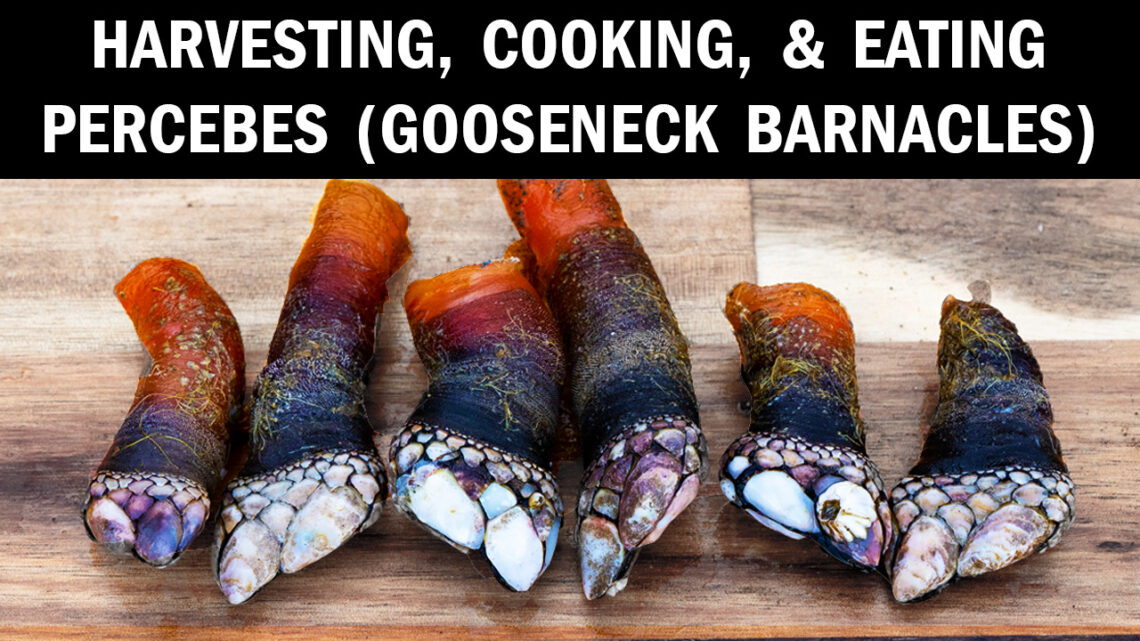These barnacles may look bizarre, but they’re edible! People risk their lives harvesting Percebes (also called Gooseneck Barnacles or Goose Barnacles) off cliffs in some parts of the world. In the Pacific Northwest of the United States though, we’re fortunate enough to live in a place where a little bit of easy rock scrambling leads to these tasty treats!
How To Harvest Percebes
There are many different methods to harvest percebes. Some people have custom tools with a metal scraper end on a wooden handle. Other people use forceps or tongs of some variety. I’ve typically just used a metal scraper/spackle knife (not plastic–they’re not strong or sharp enough) like what you’d get at a home improvement store. It can be difficult to get into clusters so I usually try to find an edge to a group and work my way in there. Or I remove some of the mussels that usually grow mixed in and then access the barnacles from the clearing from where the mussels were. You can’t just pull on the “foot” of the barnacle because you will 100% tear the edible stalk. You need to remove the barnacle at the base of the stalk where it attaches to the rock.
HARVESTING, COOKING, & EATING PERCEBES (GOOSENECK BARNACLES)
The Best Places to Find Percebes
Percebes love pounding surf that brings nutrients to them on the faces of rocks and man-made structures like piers and jetties. I find the highest concentrations of them in crevices between large rocks where waves crash through with great force, but these are rather inaccessible. The second highest concentration is usually on the lower portion of rocks only visible during low tides.
Part of the fun of foraging for barnacles is finding your own special spots. Look for rocky outcroppings with large rock formations. Anywhere with good tide pools is a good bet to start exploring. Look at aerial maps of the coastline where you live. If you see a rocky area on the beach, maybe go for a drive and have a little investigative adventure. The barnacles are more common than you’d think once you’re keeping an eye out for them.
Please don’t overharvest or take large sections from any one colony. It can take the barnacles 20+ years to recover. The larva do much better in areas already established with barnacles. If the area has none left, they may take hundreds of years to recolonize, if ever.
Regulations
Always check your state’s websites for regulations and health warnings before crabbing. These sites are where you will find the most up to date information on fishing seasons and areas, emergency closures, allowed gear, and regulations for keeping crab including size limits and whether you can keep males and/or females. Regulations regularly change, so don’t take what is written here (or anywhere other than your state’s official webpages) as the most up-to-date information. Interpretation of the regulations is up to each angler and relying entirely on what you hear or read is not an excuse if you end up fishing illegally. Just read your pamphlets please.
- Washington
- Limit is 10 lbs in shell or 5 lbs barnacle stalks per day.
- Season: Pacific Ocean Beaches Nov. 1-Mar. 31
- page 138 of WDFW recreational fishing regulations: https://www.eregulations.com/assets/docs/resources/WA/21WAFW-LR.pdf
- Oregon
- I believe gooseneck barnacles (aka goose barnacles, percebes) falls under Oregon’s “other marine invertebrates not listed” category of shellfish harvest, but I’m not 100% sure. This category only allows for the harvest of 10 barnacles per day per person. https://myodfw.com/articles/oregon-shellfish-regulations
How to Cook Percebes
Be sure to check out my YouTube channel to watch these Catch and Cook Percebes Recipes being made.

🐟 Please join the fun and hit the link above to SUBSCRIBE 🔔 to the channel if you’d like to see weekly catch and cook videos, fishing adventures, and underwater footage! THANK YOU! I appreciate you all soooo much!
As an Amazon Associate, I earn a commission from qualifying purchases made through these links. I only link products I use and recommend.

